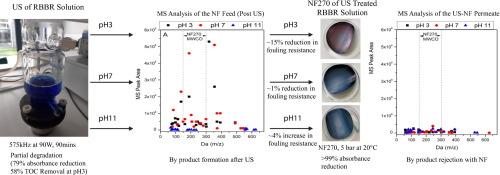Ultrasound-assisted nanofiltration for remazol brilliant blue reactive removal: elucidating the role of ph in efficacy and by-product formation
IF 6.7
2区 工程技术
Q1 ENGINEERING, CHEMICAL
引用次数: 0
Abstract
The effective treatment of dye-laden industrial effluents remains a critical challenge in environmental engineering. This study introduces a novel hybrid system integrating ultrasound (US) and nanofiltration (NF) technologies for the removal of Remazol Brilliant Blue Reactive (RBBR) dye from aqueous solutions. RBBR, a widely used textile dye, poses significant environmental and health risks due to its persistence and toxicity. For the first time, the influence of pH on the performance of a hybrid US-NF system for RBBR removal, including by-product formation and membrane fouling was systematically investigated. Initially, the US and NF processes were optimized independently by systematically varying key parameters such as US frequency, exposure time, membrane pressure, and solution pH. Ultrasonic treatment at 575 kHz resulted in 79 % reduction in absorbance and 58 % total organic carbon (TOC) removal at pH 3 after 90 min, indicating partial oxidation of the dye. NF alone consistently removed over 99 % of the dye across all tested pH values, though a flux decline of 16 % was observed at pH 3 due to fouling. The hybrid US-NF system maintained over 99 % dye rejection while completely eliminating flux decline at an optimal pH of 3, significantly outperforming the standalone NF process. Degradation by-products were confirmed via mass spectrometry and Fourier-transform infrared spectroscopy, highlighting the complementary role of NF in removing potential intermediates. These results demonstrate the potential of US–NF coupling as a robust and sustainable approach for advanced treatment of dye-contaminated wastewater, contributing to the development of cleaner industrial processes and improved water reuse practices.

超声辅助纳滤去除雷马唑亮蓝反应性:阐明ph值在效果和副产物形成中的作用
染料工业废水的有效处理仍然是环境工程中的一个重大挑战。本研究介绍了一种结合超声(US)和纳滤(NF)技术的新型混合系统,用于从水溶液中去除雷马唑亮蓝活性染料(RBBR)。RBBR是一种广泛使用的纺织染料,由于其持久性和毒性,对环境和健康构成重大风险。首次系统研究了pH对US-NF混合系统去除RBBR性能的影响,包括副产物的形成和膜污染。最初,通过系统地改变US频率、曝光时间、膜压力和溶液pH等关键参数,分别对US和NF工艺进行了优化。在575 kHz的超声波处理下,在pH为3的条件下,90分钟后,吸光度降低了79%,总有机碳(TOC)去除率降低了58%,表明染料部分氧化。在所有测试的pH值下,仅NF就能去除超过99%的染料,尽管在pH值为3时,由于污垢,通量下降了16%。混合US-NF系统保持了99%以上的染料去除率,同时在最佳pH为3时完全消除了通量下降,显著优于独立的NF工艺。降解副产物通过质谱和傅里叶变换红外光谱得到证实,强调了NF在去除潜在中间体中的补充作用。这些结果证明了US-NF耦合作为染料污染废水深度处理的稳健和可持续方法的潜力,有助于开发更清洁的工业过程和改进水的回用实践。
本文章由计算机程序翻译,如有差异,请以英文原文为准。
求助全文
约1分钟内获得全文
求助全文
来源期刊

Journal of water process engineering
Biochemistry, Genetics and Molecular Biology-Biotechnology
CiteScore
10.70
自引率
8.60%
发文量
846
审稿时长
24 days
期刊介绍:
The Journal of Water Process Engineering aims to publish refereed, high-quality research papers with significant novelty and impact in all areas of the engineering of water and wastewater processing . Papers on advanced and novel treatment processes and technologies are particularly welcome. The Journal considers papers in areas such as nanotechnology and biotechnology applications in water, novel oxidation and separation processes, membrane processes (except those for desalination) , catalytic processes for the removal of water contaminants, sustainable processes, water reuse and recycling, water use and wastewater minimization, integrated/hybrid technology, process modeling of water treatment and novel treatment processes. Submissions on the subject of adsorbents, including standard measurements of adsorption kinetics and equilibrium will only be considered if there is a genuine case for novelty and contribution, for example highly novel, sustainable adsorbents and their use: papers on activated carbon-type materials derived from natural matter, or surfactant-modified clays and related minerals, would not fulfil this criterion. The Journal particularly welcomes contributions involving environmentally, economically and socially sustainable technology for water treatment, including those which are energy-efficient, with minimal or no chemical consumption, and capable of water recycling and reuse that minimizes the direct disposal of wastewater to the aquatic environment. Papers that describe novel ideas for solving issues related to water quality and availability are also welcome, as are those that show the transfer of techniques from other disciplines. The Journal will consider papers dealing with processes for various water matrices including drinking water (except desalination), domestic, urban and industrial wastewaters, in addition to their residues. It is expected that the journal will be of particular relevance to chemical and process engineers working in the field. The Journal welcomes Full Text papers, Short Communications, State-of-the-Art Reviews and Letters to Editors and Case Studies
 求助内容:
求助内容: 应助结果提醒方式:
应助结果提醒方式:


